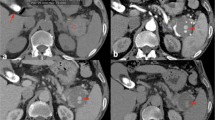Abstract
Post-pancreatitis pseudoaneurysms are not uncommon. They have a high associated mortality due to a propensity to rupture. Current standards of treatment advocate immediate intravascular interventions. We describe two cases of alcohol-related post-acute pancreatitis pseudoaneurysms arising from the second-order branches of the superior mesenteric artery (SMA) that were endoluminally inaccessible. Both cases were successfully treated with percutaneous thrombin injection into the pseudoaneurysm sac under ultrasound guidance. We suggest that endoluminally inaccessible pseudoaneurysms that are percutaneously accessible can be expeditiously treated with percutaneous thrombin injection. Further, due to the efficaciousness of this procedure, it could be considered as a first-line minimally invasive therapeutic option.



Similar content being viewed by others
References
Hamel E, Parc A, Adda R, et al. Bleeding pseudocysts and pseudoaneurysms in chronic pancreatitis. Br J Surg. 1991;78:1059–63.
Tadao M, Yuji O. Role of free radicals in the development of severe acute pancreatitis. Nippon Rinsho. 2004;62:2015–20.
Schwartz LB, Clark ET, Gewertz BL. Anastomotic and other pseudoaneurysms. In: Rutherford RB, editor. Vascular surgery. 5th ed. Philadelphia: Saunders; 2000. p. 752–63.
Manazer JR, Monzon JR, Dietz PA, et al. Treatment of pancreatic pseudoaneurysm with percutaneous transabdominal thrombin injection. J Vasc Surg. 2003;38:600–2.
Kresowik TF, Khoury MD, Miller BV, et al. A prospective study of the incidence and natural history of femoral vascular complications after percutaneous transluminal coronary angioplasty. J Vasc Surg. 1991;13:328–33.
Munera F, Soto JA, Palacio D, et al. Diagnosis of arterial injuries caused by penetrating trauma to the neck: comparison of helical CT angiography and conventional angiography. Radiology. 2000;216:356–62.
Saad NE, Saad WE, Davies MG, et al. Pseudoaneurysms and the role of minimally invasive techniques in their management. Radio Graph. 2005;25:S173–89.
Kang SS, Labropoulos N, Mansour MA, et al. Expanded indications for ultrasoundguided thrombin injection of pseudoaneurysms. J Vasc Surg. 2000;31:289–98.
Author information
Authors and Affiliations
Corresponding author
Ethics declarations
Conflict of interest
Udit Chauhan, Sunil Puri, Neeraj Jain, Lalit Garg, Abhay Kapoor, Nishant Gupta, and Vandana Goel declare that there are no conflicts of interest.
Ethical consideration
All procedures followed were in accordance with the ethical standards of the responsible committee on human experimentation (institutional and national) and with the Helsinki Declaration of 1975, as revised in 2008 [5]. Informed consent was obtained from all patients for being included in the study.
About this article
Cite this article
Chauhan, U., Puri, S.K., Jain, N. et al. Percutaneous thrombin injection under sonographic guidance for exclusion of non-catheterizable post-pancreatitis pseudoaneurysm of the superior mesenteric artery: a minimally invasive and expeditious treatment option. J Med Ultrasonics 43, 295–299 (2016). https://doi.org/10.1007/s10396-015-0687-4
Received:
Accepted:
Published:
Issue Date:
DOI: https://doi.org/10.1007/s10396-015-0687-4




